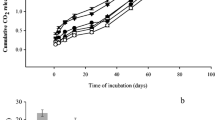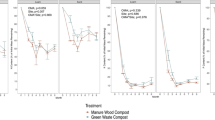Abstract
Application of organic fertilizers and charcoal increase nutrient stocks in the rooting zone of crops, reduce nutrient leaching and thus improve crop production on acid and highly weathered tropical soils. In a field trial near Manaus (Brazil) 15 different amendment combinations based on equal amounts of carbon (C) applied through chicken manure (CM), compost, charcoal, and forest litter were tested during four cropping cycles with rice (Oryza sativa L.) and sorghum (Sorghum bicolor L.) in five replicates. CM amendments resulted in the highest (P < 0.05) cumulative crop yield (12.4 Mg ha−1) over four seasons. Most importantly, surface soil pH, phosphorus (P), calcium (Ca), and magnesium (Mg) were significantly enhanced by CM. A single compost application produced fourfold more grain yield (P < 0.05) than plots mineral fertilized in split applications. Charcoal significantly improved plant growth and doubled grain production if fertilized with NPK in comparison to the NPK-fertilizer without charcoal (P < 0.05). The higher yields caused a significantly greater nutrient export in charcoal-amended fields, but available nutrients did not decrease to the same extent as on just mineral fertilized plots. Exchangeable soil aluminum (Al) was further reduced if mineral fertilizer was applied with charcoal (from 4.7 to 0 mg kg−1). The resilience of soil organic matter (SOM) in charcoal amended plots (8 and 4% soil C loss, mineral fertilized or not fertilized, respectively) indicates the refractory nature of charcoal in comparison to SOM losses over 20 months in CM (27%), compost amended (27%), and control plots (25% loss).





Similar content being viewed by others
References
Baldock JA, Smernik RJ (2002) Chemical composition and bioavailability of thermally altered Pinus resinosa (Red pine) wood. Org Geochem 33:1093–1109
Bengtsson G, Bengtson P, Månsson KF (2003) Gross nitrogen mineralization-, immobilization-, and nitrification rates as a function of soil C/N ratio and microbial activity. Soil Biol Biochem 35:143–154
Box GEP, Cox DR (1964) An analysis of transformations. J R Stat Soc Ser B.26:211–252
Brady NC, Weil RR (2001) The nature and properties of soils. Prentice Hall, Englewood Cliffs, NJ
Burger M, Jackson LE (2003) Microbial immobilization of ammonium and nitrate in relation to ammonification and nitrification rates in organic and conventional cropping systems. Soil Biol Biochem 35:29–36
Cheng CH, Lehmann J, Thies JE, Burton SD, Engelhard MH (2006) Oxidation of black carbon by biotic and abiotic processes. Org Geochem 37:1477–1488
Claessen MEC, Barreto WdO, Paula JLd, Duarte MN (1997) Manual de metodos de analise de solo. EMBRAPA, Rio de Janeiro, p 212
Correia FWS, Lieberei R (1998) Agroclimatological information about the experimental field of the SHIFT-area, ENV 23, 42, 45, 52. In: Lieberei R, Biachi H, Voss K (eds) Third SHIFT workshop, Manaus, March 1998, 1998. BMBF, Germany, pp 389–396
Denevan WM (1996) A bluff model of riverine settlement in prehistoric Amazonia. Ann Assoc Am Geogr 86(4):654–681
Duxbury JM, Smith MS, Doran JW, Jordan C, Szott L, Vance E (1989) Soil organic matter as a source and a sink of plant nutrients. In: Coleman DC, Oades JM, Uehara G (eds) Dynamics of soil organic matter in tropical ecosystems. University of Hawaii Press, Honolulu, pp 33–67
Fageria NK (1998) Manejo da calagem e adubacao do arroz. Embrapa Arroz e Feijao, Santo Antonio de Goias, GO, pp 67–79
FAO (1990) Soil map of the world, revised legend. FAO, Rome, Italy
Fearnside PM (1997) Greenhouse gases from deforestation in Brazilian Amazinia: net committed emissions. Clim Chang 35:321–360
Fearnside PM, Lima PM, Graça A, Rodrigues FJA (2001) Burning of Amazonian rainforest: burning efficiency and charcoal formation in forest cleared for cattle pasture near Manaus, Brazil. For Ecol Manage 146:115–128
Giardina CP, Sanford RL, Dockersmith IC, Jaramillo VJ (2000) The effects of slash burning on ecosystem nutrients during the land preparation phase of shifting cultivation. Plant Soil 220:247–260
Glaser B, Guggenberger G, Haumaier L, Zech W (2001a) Persistence of soil organic matter in archaeological soils (Terra Preta) of the Brazilian Amazon region. In: Rees RM, Ball BC, Campbell CD, Watson CA (eds) Sustainable management of soil organic matter. CABI Publishing, Wallingford, pp 190–194
Glaser B, Haumaier L, Guggenberger G, Zech W (2001b) The “terra preta” phenomenon: a model for sustainable agriculture in the humid tropics. Naturwissenschaften 88:37–41
Glaser B, Lehmann J, Zech W (2002) Ameliorating physical and chemical properties of highly weathered soils in the tropics with charcoal—a review. Biol Fertil Soils 35:219–230
Goldammer JG (1993) Historical biogeography of fire: tropical and subtropical. In: Crutzen PJ, Goldammer JG (eds) Fire in the environment: the ecological atmospheric, and climatic importance of vegetation fires. Wiley, New York, pp 297–314
Hölscher D, Ludwig B, Möller RF, Fölster H (1997a) Dynamic of soil chemical parameters in shifting agriculture in the Eastern Amazon. Agric Ecosyst Environ 66:153–163
Hölscher D, Möller RF, Denich M, Fölster H (1997b) Nutrient input-output budget of shifting agriculture in Eastern Amazonia. Nutr Cycl Agroecosys 47:49–57
Hughes RF, Kauffman JB, Cummings DL (2000) Fire in the Brazilian Amazon 3. Dynamics of biomass, C, and nutrient pools in regenerating forests. Oecologia 124:574–588
Kleinman PJA, Pimentel D, Bryant RB (1995) The ecological sustainability of slash-and-burn agriculture. Agric Ecosyst Environ 52:235–249
Kuhlbusch TA, Lobert JM, Crutzen PJ, Warneck P (1991) Molecular nitrogen emissions from denitrification during biomass burning. Nature 351:135–137
Kuhlbusch TAJ, Crutzen PJ (1995) Toward a global estimate of black carbon in residues of vegetation fires representing a sink of atmospheric CO2 and a source of O2. Global Biogeochem Cycles 9:491–501
Lehmann J, Campos CV, Macedo JLV, German L (2004) Sequential fractionation and sources of P in Amazonian dark earths. In: Glaser B, Woods WI (eds) Amazonian dark earths: exploration in time and space. Springer Verlag, Heidelberg, pp 113–123
Lehmann J, da Silva JP Jr, Rondon M, Cravo MdS, Greenwood J, Nehls T, Steiner C, Glaser B (2002) Slash and char—a feasible alternative for soil fertility management in the central Amazon? In: Proceedings of the 17th world congress of soil science, Bangkok, Thailand, 14–21. 08. 2002, Ed T I U o S Sciences, pp 449-1–449-12
Lehmann J, da Silva JP Jr, Steiner C, Nehls T, Zech W, Glaser B (2003) Nutrient availability and leaching in an archaeological Anthrosol and a Ferralsol of the Central Amazon basin: fertilizer, manure and charcoal amendments. Plant Soil 249:343–357
Lehmann J, Feilner T, Gebauer G, Zech W (1999) Nitrogen uptake of sorghum (Sorghum bicolor L.) from tree mulch and mineral fertilizer under high leaching conditions estimated by nitrogen−15 enrichment. Biol Fertil Soils 30:90–95
Lehmann J, Gaunt J, Rondon M (2006) Bio-char sequestration in terrestrial ecosystems—a review. Mitig Adapt Strateg Global Change 11:403–427
Lewis J, Vosti S, Witcover J, Ericksen PJ, Guevara R, Tomich T (2002) Alternatives to slash-and burn in Brazil. World Agroforestry Centre (ICRAF), Nairobi, pp 1–100
Liang B, Lehmann J, Solomon D, Grossman J, O’Neill B, Skjemstad JO, Thies J, Luizão FJ, Petersen J, Neves EG (2006) Black carbon increases cation exchange capacity in soils. Soil Sci Soc Am J 70:1719–1730
Lima HN, Schaefer CER, Mello JWV, Gilkes RJ, Ker JC (2002) Pedogenesis and pre-Colombian land use of “Terra Preta Anthrosols” (“Indian black earth”) of Western Amazonia. Geoderma 110:1–17
Materechera SA, Mkhabela TS (2002) The effectiveness of lime, chicken manure and leaf litter ash in ameliorating acidity in a soil previously under black wattle (Acacia mearnsii) plantation. Bioresour Technol 859–816
McLean EO (1965) Aluminium. In: Black CA (ed) Methods of soil analysis part 2: chemical and microbiological properties. Am. Soc. Agron, Madison, pp 986–994
Mehlich A (1984) Mehlich-3 Soil test extractant: a modification of Mehlich-2 extractant. Commun Soil Sci Plant Anal 15:1409–1416
Ogawa M (1994) Symbiosis of people and nature in the tropics. Farming Jp 28(5):10–30
Olsen SR, Sommers LE (1982) Phosphorus. In: Page AL, Miller RH, Keeney DR (eds) Methods of soil analyses: part 2 chemical and microbiological properties. Am. Soc. Agron, Wisconsin, pp 403–430
Renck A, Lehmann J (2004) Rapid water flow and transport of inorganic and organic nitrogen in a highly aggregated tropical soil. Soil Sci 169:330–341
Sanchez P (1976) Properties and management of soils in the tropics. Wiley, New York
Sierra J, Noël C, Dufour L, Ozier-Lafontaine H, Welcker C, Desfontaines L (2003) Mineral nutrition and growth of tropical maize as affected by soil acidity. Plant Soil 252:215–226
Silva-Forsberg MC, Fearnside PM (1995) Agricultural management of caboclos of the Xingu river: a starting point for sustaining populations in degraded areas in the Brazilian Amazon. In: Parrotta JA, Kanashiro M (eds) Management and rehabilitation of degraded lands and secondary forests in Amazonia. International Institute of Tropical Forestry, Rio Piedras, pp 90–95
Silvester-Bradley R, Oliveira LAD, Filho JADP, John STV (1980) Nodulation of legumes, nitrogenase activity of roots and occurrance of nitrogen-fixing Azospirillum spp. in representative soils of central Amazonia. Agro-Ecosyst 6:249–266
Sombroek WG, Nachtergaele FO, Hebel A (1993) Amounts, dynamics and sequestering of carbon in tropical and subtropical soils. Ambio 22:417–426
Steiner , Teixeira WG, Lehmann J, Zech W (2004a) Microbial response to charcoal amendments of highly weathered soils and amazonian dark earths in central Amazonia—preliminary results. In: Glaser B, Woods WI (eds) Amazonian dark earths: explorations in space and time. Springer Verlag, Heidelberg, pp 195–212
Steiner C, Teixeira WG, Zech W (2004b) Slash and char: an alternative to slash and burn practiced in the Amazon basin. In: Glaser B, Woods WI (eds) Amazonian dark earths: explorations in space and time. Springer Verlag, Heidelberg, pp 183–193
Tiessen H, Cuevas E, Chacon P (1994) The role of soil organic matter in sustaining soil fertility. Nature 371:783–785
Topoliantz S, Ponge J-F, Ballof S (2005) Manioc peel and charcoal: a potential organic amendment for sustainable soil fertility in the tropics. Biol Fertil Soils 41:15–21
Walinga I (1995) Digestion in tubes with H2SO4–salicylic acid-H2O2 and selenium and determination of Ca, K, Mg, N, Na, P, Zn. In: Walinga I, Lee JJvd, Houba VJG, Vark Wv, Novozamsky I (eds) Plant analysis manual. Kluwer Academic Publishers, Dordrecht, The Netherlands
Zech W, Haumaier L, Hempfling R (1990) Ecological aspects of soil organic matter in the tropical land use. In: McCarthy P, Clapp C, Malcolm RL, Bloom PR (eds) Humic substances in soil and crop sciences; selected readings. American Society of Agronomy and Soil Science Society of America, Madison, pp 187–202
Acknowledgments
The research was conducted within SHIFT ENV 45, a German–Brazilian cooperation and financed by the Bundesministerium für Bildung und Forschung (BMBF), Germany and Conselho Nacional de Desenvolvimento Científico e Tecnológico (CNPq), Brazil (BMBF No. 0339641 5A, CNPq 690003/98–6). A financial contribution was given by the doctoral scholarship program of the Austrian Academy of Sciences. We are grateful for the fieldworkers’ help particularly Luciana Ferreira da Silva and Franzisco Aragão Simão and the laboratory technician Marcia Pereira de Almeida. Critical comments and help were given by Prof. Dr. William I. Woods, Dr. Bruno Glaser, Jago Birk, and Heiko Grosch.
Author information
Authors and Affiliations
Corresponding author
Rights and permissions
About this article
Cite this article
Steiner, C., Teixeira, W.G., Lehmann, J. et al. Long term effects of manure, charcoal and mineral fertilization on crop production and fertility on a highly weathered Central Amazonian upland soil. Plant Soil 291, 275–290 (2007). https://doi.org/10.1007/s11104-007-9193-9
Received:
Accepted:
Published:
Issue Date:
DOI: https://doi.org/10.1007/s11104-007-9193-9




